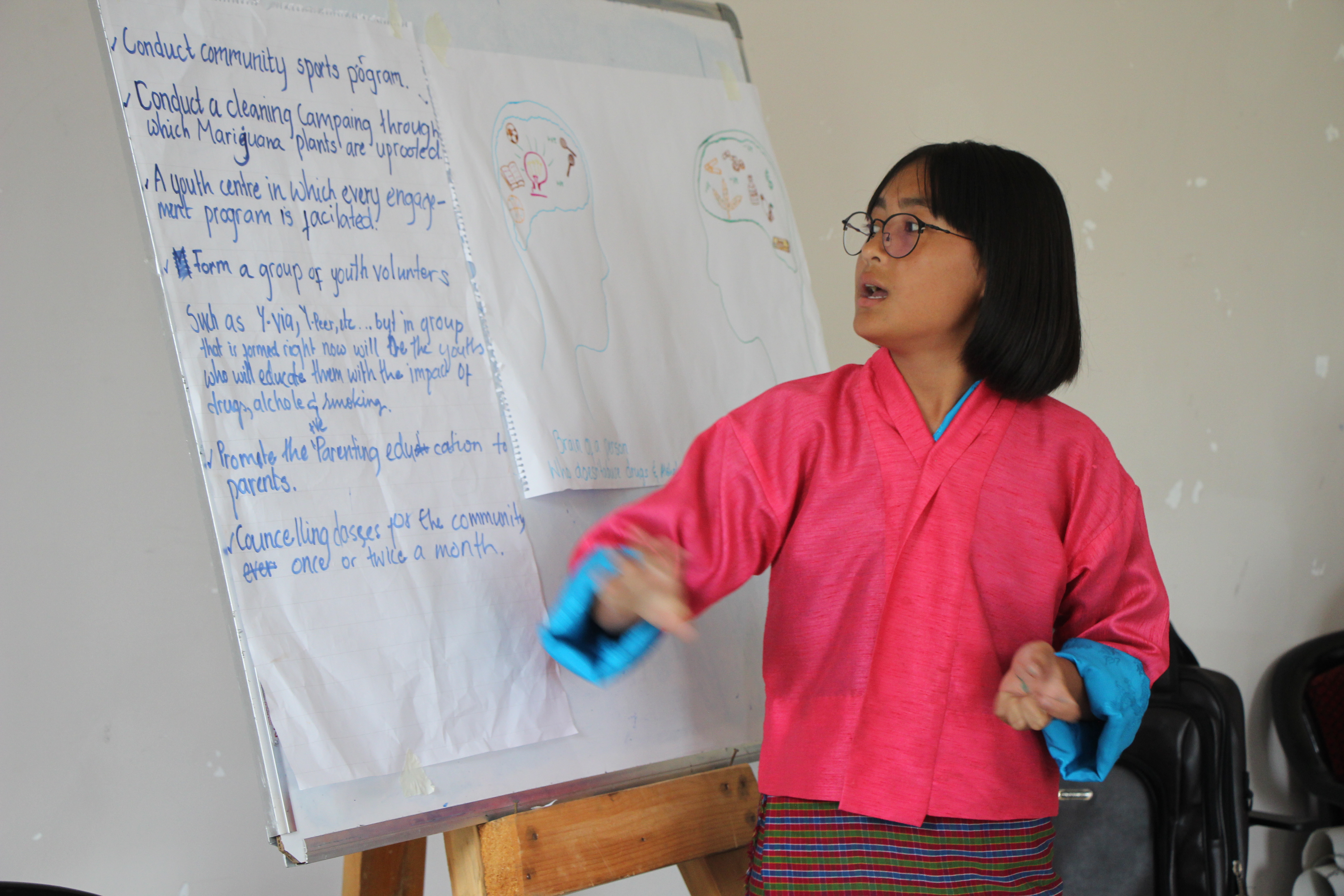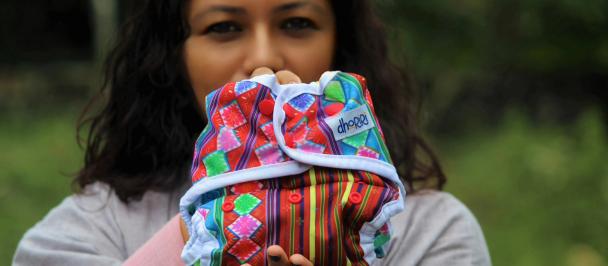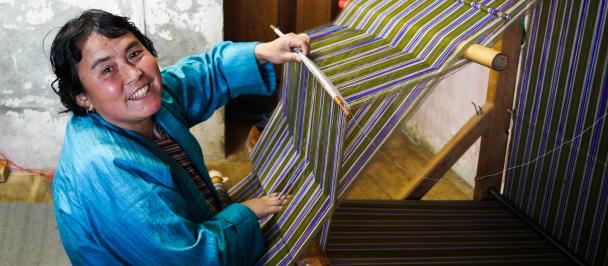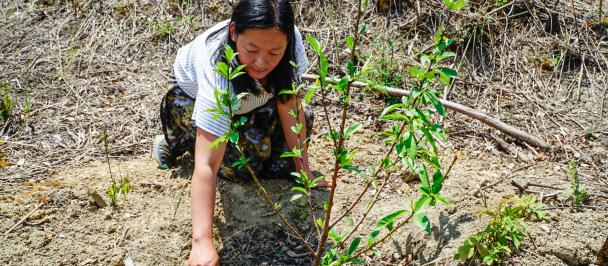Lhakee Tasreen Yigzeen presents her group's ideas and strategies to address root causes of violence at the Social Innovation Camp
Lhakee Tasreen Yigzeen is a class nine student of Babesa Higher Secondary School (BHSS) in Bhutan's capital Thimphu. The 13-year-old is among the 150 students of her school who took part in the first-ever Social Innovation Camp by the National Commission for Women and Children (NCWC) and UNDP Bhutan.
The Institute of Management Studies (IMS) in Serbithang where the camp was held was abuzz with activities as Lhakee and her friends worked in groups over the weekend to come up with innovative solutions, ideas and ways to prevent the two main triggers or causes of violence- drug abuse and alcohol addiction.
With the theme Promoting Positive Coping and Stress Management Strategies and Avoidance of Alcohol and Drug Abuse, the camp was organized as a part of the Bhutan Pilot Project: Addressing Violence Against Women and Children (VAWC). The project is being piloted in Babesa Community by NCWC in partnership with UNDP.
The project seeks to address the root causes of prolematic social norms that lead to VAWC to achieve the Sustainable Development Goals (SDGs).
Students taking active part in group activities at the Social Innovation Camp
Babesa HSS is the pilot school and its students were engaged through club sessions reflecting and learning on various topics related to the theme over the past three months.
“I have often heard of youth being referred to as the future leaders but it's only now that I understand what it really means,” Lhakee said. “This project has been an eye opener. It has especially helped us understand the role of adolescents in influencing and driving positive social change aimed at preventing Gender Based Violence (GBV).”
The pilot project in Bhutan is one of the seven pilots across the world supported by UNDP and the Republic of Korea global initiative focused on the integration of actions to address GBV.
A woman in rural Bhutan cooking on traditional mud stove
Violence Against Women and Girls Scenario in Bhutan
The Ministry of Health’s 2017 report on responses to VAW at different levels of Health Facilities in Bhutan reported 1557 cases of GBV between June 2015 and July 2016.
The latest report on VAWG, 2017 show that more than half (53.3%) of all women agree that a husband or man is justified to hit them. The report also reveals the impact of emotional violence to be traumatic and physical partner violence affects many women in Bhutan. More than two in every five women (44.6%) have experienced one or more forms of partner violence in their lifetime, be it physical, sexual, psychological or economic.
Further, 12.5% of women experienced physical violence from persons other than their intimate partner since the age of 15. Young women report the highest rates of physical violence by non-partners with about 20% of women aged 15-24 years having experienced this in their lifetime. Almost one in ten women reported being sexually abused as a child.
Reena Thapa, one of the caregivers, at the Workshop for Facilitator early this year
Gender Based Violence and Sustainable Development Goals
Ending violence against women is a stand-alone Sustainable Development Goal, which strives to ‘eliminate all forms of violence against all women and girls in both public and private spheres, including trafficking and sexual and other types of exploitation.’
GBV elimination is also a prerequisite for achieving not only SDG5 Gender Eqaulity but also many other SDGs with over 80 SDG indicators intricately linked with SGD 5.2. Integrating GBV prevention and response into “non-GBV-focused” programmes and policies has massive positive spill-over effects across multiple SDGs.
Through the Bhutan Pilot Project: Addressing Violence Against Women and Children (VAWC), Bhutan is piloting integrated, innovative approaches and new forms of collaboration to eliminate GBV.
The intervention engages two primary beneficiary groups- caregivers and adolescents- and these beneficiaries are being empowered to be changemakers in their community and lead broader community engagement activities. The overall primary focus of the intervention is on promoting and nurturing Safe, Happy, and Equitable Families.
The project’s approach is inclusive and participatory, collaborating with several relevant stakeholders, such as the Thimphu City Mayor’s Office, Ministry of Health, Ministry of Education, Royal Bhutan Police, RENEW and Nazhoen Lamtoen (national CSO).
Adolescents Group
Adolescence is a critical time to influence ideas, attitudes, decision-making skills, behavior and practices. The recent Social Innovation camp on Promoting Positive Coping and Stress Management Strategies and Avoidance of Alcohol and Drug Abuse was the first of the three such camps planned under the project. The next two Social Innovation Camps will focus on Gender Equality and Community Activity and Safe and Happy Realtionships.
Adolescents are engaged in sessions promoting VAWC prevention and supported to develop solutions to implement in their friendships, homes, schools and or communities to address key causes of VAWC. These social innovation solutions will serve as a means to implement an action learning process, in which adolescents will implement their projects themselves and in partnership with caregiver groups or community groups.
Caregivers' Group
Parallel sessions with caregivers – including parents, guardians, relatives, teachers, and others who shoulder care giving responsibilities –are being conducted. The series of participatory workshops and dialogue with caregivers will build positive parenting and gender equitable parenting skills and seek to cultivate them as role models on issues of gender equality, coping with stress and promoting community involvement.
Caregiver sessions also delve on topics, such as positive discipline, positive communication and conflict resolution. Through strengthened relationships and role modeling, it is expected that care-givers will promote non-violence, and demonstrate the values of respect, caring, and empathic concern to support adolescents’ future success.
The project is expected to help influence change among the beneficiaries in their attitudes and knowledge on gender equality, stress and coping, and positive, happy relationships. Also, the ideas and projects emanating from the social innovation camps will empower and inspire adolescents and their caregivers to participate in civic engagement to address social issues related to VAWC affecting their community.

 Locations
Locations


